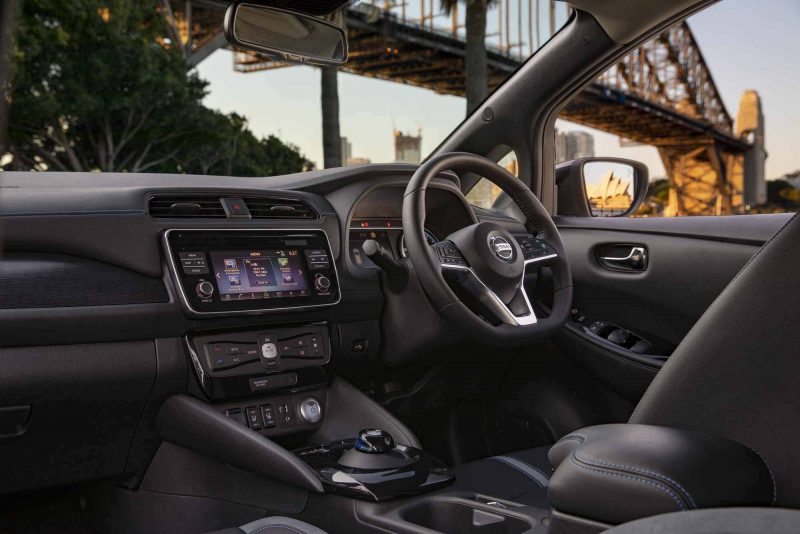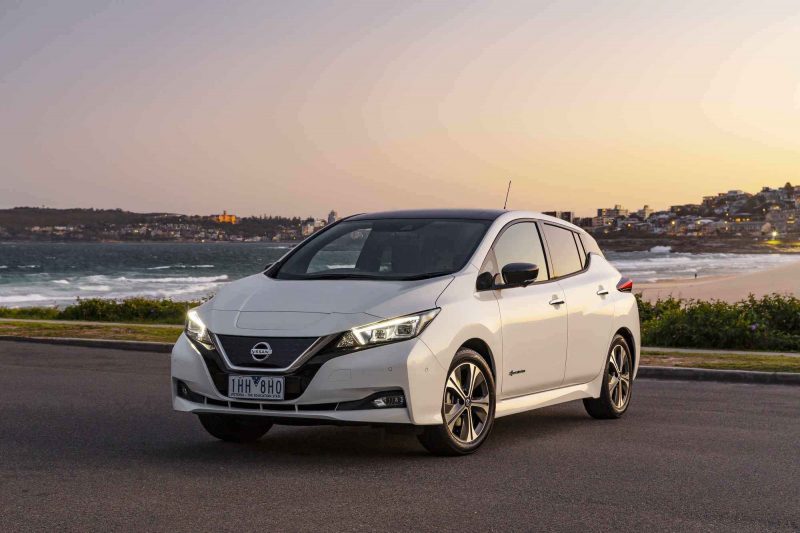Motoring giant Nissan unveiled its new Australian-version Leaf on Thursday morning, promising that a bigger 40kWh battery will give an extended fully charged range of 270kms.
The new generation Leaf joins a growing number of electric cars from car makers who are at last beginning to take the Australian market seriously, and at prices signifiants lower than the luxury models available recently, even if they remain beyond the means of most consumers.
This year and into next the Leaf will join the Tesla 3, Hyundai Ioniq, Audi e-tron and Kia Soul, as well as more expensive beasts including Jaguar’s i-PACE and the Mercedes-Benz EQ range as new models on the market.

However, this new Leaf – which is already on sale in overseas markets – will not come to Australia shores until at least June next year and while there are no pricing details yet, expect on dealer forecourts at around $50,000.
The new Leaf is very different to the model is replaces (635 of the first generation Leaf were sold here, and some 350,000 worldwide) with a more conventional and yet modern look, and it’s packed with technology.
There’s all-round video monitoring, predictive forward collision warning, heated front and rear seats and a heated steering wheel, blind spot warning, traffic sign recognition, intelligent emergency braking if a pedestrian steps out, rear cross traffic alert, and intelligent cruise control.
Performance is claimed to be impressive thanks to 110kW of power and 320Nm of torque, allowing the Leaf to cover the 0-100km/h sprint in just over seven seconds.
The car also features what Nissan calls an e-Pedal (actually the accelerator) which means you rarely need to use the brakes at all. Using the one pedal allows the driver to start off, accelerate, decelerate, stop and hold the car using just the one pedal.
The brake pedal still needs to be used for really hard braking but otherwise the e-Pedal is the only one you need to use. Nissan reckon it will change the way we all drive.

The new Leaf provides vehicle to home bi-directional charging, which means the Leaf can be used to charge your home electric system (if you have solar) during the night, so the home always has power. When it’s light the car can be recharged, so creating a closed circle and saving on electricity costs.
Nissan were first to produce a mass-market electric car with the original Leaf and they are pushing ahead with plans to have at least a third of their sales electric in Australia in the next few years, as they roll out electric versions of most of their models.

“Electrified vehicles will represent a third of Nissan volume in Australia during our mid-term plan,” said Nissan Australia managing director, Stephen Lester.
“By introducing more electric alternatives on several of our key models, we will make mass market electrification a reality.
“I have no doubt electric vehicles will be a success here, and sooner than many think, and Nissan is planning for this now to ensure we meet the future needs of the buyer.”
“The new Nissan Leaf has the ability to transform the way we drive and live,” said Mr Lester.
“The increase in power and particularly torque make this vehicle a lot of fun to drive, surprising many who get to experience it.
“The larger 40 kilowatt hour battery will keep the Leaf on the road for longer and with bi-directional charging capabilities, you could feed charge from the car to power your home.”

With range anxiety a major consideration for EV buyers in Australia – even though most Aussies only drive around 38km a day – Nissan’s global research shows current owners approach the re-charging of their vehicle’s battery in the same way as their mobile phone.
“Charging is a simple act and many EV owners tend to charge their vehicle like they charge their mobile phones in preparation for the next day, by doing it overnight,” said Mr Lester.
“A study by Zero Carbon Australia tells us that, on average, city-based drivers have a 38 kilometre daily commute, so daily re-charging is not necessary.
“Also, with a conscious mindset of overnight charging well in place thanks to mobile phones, most Australians are unlikely to have range issues.”

For the first-generation Leaf, Nissan had 12 specialist dealers across Australia. When the new model arrives they will have 89 and the company has also just signed a deal with Jet Charge to put charging stations in each of those dealers so you can charge your Leaf for free.
It will also be possible to get a wall mounted charging system for your home through Nissan dealers.
“Strong electric vehicle policy is also important,” said Mr Lester.
“Countries with higher electric vehicle take-up have more charging points and offer tax cuts, toll discounts, parking concessions and more to inspire consideration and purchase.”
Tony Bosworth writes for www.TheDriven.io and RenewEconomy.com.au. He has 35 years experience in journalism, and has been instrumental in launching and editing several automotive magazines including Which Car? magazine in the UK.

